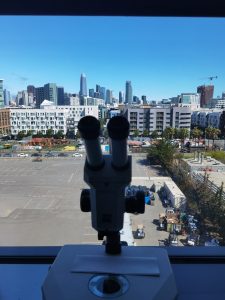25 April 2023

Multiple sclerosis (MS) is a central nervous system demyelinating disease with heterogeneous clinical manifestations. Most MS patients start with reversible neurological deficits, which is the relapsing-remitting MS (RRMS) subtype that could be controlled by disease-modifying therapies and anti-CD20 therapeutics.
Incomplete neurological recovery of RRMS at a chronic stage may lead to a progressive phase marked by neurodegeneration, and around 10-20% of MS patients manifest primary progressive MS (PPMS) with no remission after disease onset, which is also ascribed to the ongoing neurodegeneration. Whilst treatments are available for RRMS, unmet needs for MS patients are novel treatments that focus on neuroprotection and a greater understanding of the mechanisms of neurodegeneration in progressive MS.
With the Travelling Fellowship from Journal of Cell Science, Keying Zhu, a PhD student from the Robert Harris group at Karolinska Institute had the chance to visit Dr. Stephen Fancy’s lab at the University of California San Francisco (UCSF) for two months to work with an exciting project in collaboration with Dr. David Rowitch who has previously identified that a group of neurons (Cux2-expressing excitatory neurons) are more prone to be lost in MS, with dysregulated stress responses.
Apart from being a labelling marker of the layer 2/3 neurons in the outer cortex, little is known about the role of Cux2. In Dr. Fancy’s lab, a very productive postdoc Wenlong has established an array of transgenic mouse tools to study the role of Cux2, including the Cux2-cre/+ and Cux2-cre/cre (null) mice that were also crossed with strains with floxed sites at key transcriptional factors related to cell stress responses. The lab has observed interesting phenotypes in terms of the abnormal cortex and cerebellar development when Cux2 is absent, which is not only relevant to neurodegeneration in MS but also sheds light on novel therapeutic targets for medulloblastoma, which is a brain cancer originating from the cerebellum and is primarily present in children. More evidence and findings shall be revealed with the progress of the projects.
During the stay in Dr. Fancy’s lab, Keying helped analyse the single nucleus RNA sequencing data and examined cortex and cerebellar neuronal structure as well as neuronal apoptosis in the two brain regions by performing immunostainings. Meanwhile, as he has worked with rodent demyelinating models before, he also assisted the lab in establishing a cuprizone-induced mouse demyelinating model to further unravel the role of Cux2 in a more disease-relevant context. By working closely with the lab members, he also gained new knowledge about cortex and cerebellar development, the disease phenotypes and mechanisms of medulloblastoma, the function of the primary cilium, plasmid cloning and transfection, as well as the hands-on experience in the application of shRNA interference.

During the research visit, Keying also connected with other researchers at UCSF, a prestige university for neuroscience, and got to know different research fields that broadened his horizon. Outside the lab, he also enjoyed the sunshine in California and the joyful lab outing.








You must be logged in to post a comment.